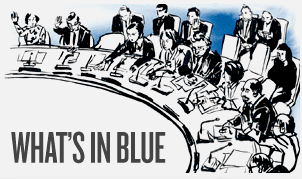Consultations on a draft joint letter for the appointment of the Secretary-General
Council members will meet today (18 November), under “any other business” to discuss the contents of a draft joint letter which would formally launch the selection process for the next Secretary-General. The letter was circulated to all 15 members on Monday evening (16 November). It seems this draft text is based on a UK draft which incorporates inputs from the Office of the President of the General Assembly (OPGA).
Following the adoption on 11 September of General Assembly resolution 69/321, which calls for the Security Council and General Assembly presidents to start the Secretary-General appointment process through a joint letter describing the process, there was interest from a number of Council members as well as the OPGA in finalising a joint letter before the end of the year. Resolution 69/321 also paved the way for a more collaborative process between the Council and General Assembly. In early October, Spain as president of the Council, met with the President of the General Assembly (PGA) and it seems that the possible contents of a joint letter were discussed. On 2 November, the UK, this month’s Council president, met with the PGA and discussed the draft letter.
Following feedback from the OPGA, it seems the UK amended its draft to include details from resolution 69/321 which had been missing. The draft text circulated to all 15 members sets out some of the qualities and experience expected in candidates for the position of UN Secretary-General. This is in line with resolution 69/231, which was the first resolution since resolution 60/286 of 2006 to elaborate on the qualities expected in a Secretary-General. Other aspects of resolution 69/231 which are reflected in the draft letter include the intention of the two presidents to jointly circulate, on an ongoing basis, the names of candidates being considered. The holding of informal dialogues or meetings with the General Assembly which was also in resolution 69/231 is included in the letter. It further suggests Arria-formula meetings as a possible format for interaction with Council members.
An area that is expected to require some negotiation among Council members is the inclusion of a timeline in the draft letter. This had been a sensitive issue during negotiations on the General Assembly resolution, and rather than specify a time line, resolution 69/321 simply asks candidates to declare their interest in a timely manner. The draft letter suggests that the appointment process could be concluded three to four months before the end of the current Secretary-General’s term, and that candidates ideally should express their interest in the position in the first quarter of 2016. Both the US and Russia have indicated that they would prefer not to have a rigid timeline as they want to keep open the possibility of additional candidates being considered. The draft letter apparently includes language that opens up the possibility of candidates continuing to come forward throughout the process. The draft letter does not emphasise geographic distribution, although, in line with resolution 69/231, it invites the presentation of women candidates.
This will not be the Council’s first discussion on the appointment of the Secretary-General. Council members discussed this issue during the Council’s 30 June wrap-up and during consultations on 22 July. It was also raised by a number of members during the working methods debate last month. However, tomorrow’s exchange of views will be the first opportunity for most Council members to express their opinion on the contents of the draft joint letter. Russia has over the last few months made clear that it believes the selection process for the next Secretary-General should only start next year when the full Council membership that will decide on the next Secretary-General is in place. However, some members have argued that as the incoming elected members are already attending Council meetings, they are able to participate in any discussions that take place in the remainder of this year. It is unclear whether Russia will continue to oppose having the joint letter go out this year if the majority of Council members favour this. China has not been particularly vocal with regard to the contents of the letter, but like Russia and the US may have some concerns regarding definition of a timeline.
While today’s discussion is expected to focus largely on the draft joint letter, some members may see this as an opportunity for a wider discussion on the next steps in the appointment process. Elected members like Angola, Chile, Malaysia, New Zealand, Spain and Venezuela are likely to emphasise the importance of transparency and accountability in moving forward as they did as part of their joint statement during the Working Methods open debate on 20 November.
For more information on the Secretary-General selection process see SCR’s Research Report on the Appointing the Secretary-General.

